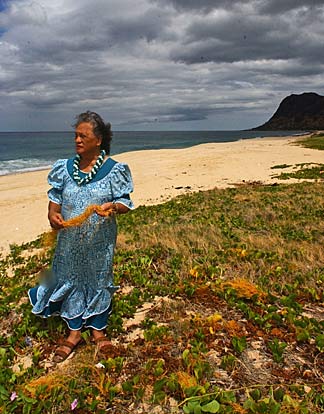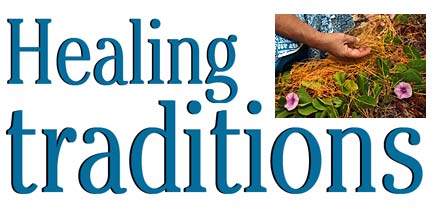
|

Native Hawaiian practice
gains prominence in the isles
It was Tuesday and the volleyball player at Punahou School had a painful sprained finger, but wanted to play that Friday.
Alapai Kahuena received a call and went to look at the girl, the granddaughter of a friend.
Kahuena, a practitioner of native Hawaiian healing, pounded leaves of ha'uoi, a plant also known as verbena, and mixed it with a pinch of Hawaiian salt. After massaging the girl's arm, she placed the mixture on the injured finger, wrapped it in gauze and told the girl to leave it on for three days.
"Her mother later told me the pain went away and the girl was able to play on Friday," Kahuena said.
A growing number of Hawaii residents are turning to traditional healing practices as an alternative or a supplement to visiting a regular doctor.
Traditional healing practices also are being combined with standard medicine in state-supported health care programs for native Hawaiians, although there is a shortage of Hawaiian healers. The University of Hawaii also has a new department that recognizes and studies Hawaiian medicine.
"People are not happy with Western medical treatment and are seeking alternatives," said Babette Galang, complementary health officer for Papa Ola Lokahi, a nonprofit group set up to improve the health and well-being of native Hawaiians.
Traditional healing goes on in a variety of settings around the islands -- in clinics and community health centers as well as private homes and public parks.
"We're not just talking about Hawaiians," Galang said. "The Chinese brought their medicines, and many Chinese herbal shops are found in Chinatown.
"But the Hawaiians always have been here," she said.
Kahuena frequently uses an herb called olena, a ginger family plant also known as turmeric, to treat several ailments. It's antibacterial and anti-inflammatory, she said.
Kahuena said she tries all herbs before prescribing them, and is using olena herself for treatment of diabetes and heart problems. She hopes eventually to be free of her Western medicines.
"People want a quick fix, but that's not how it works," Galang said. "It's a whole way of looking at life, a whole way of living, taking care of yourself."
Both Kahuena and Galang emphasize the spiritual element of traditional healing.
"Ke Akua (God) is the foundation," Kahuena said. "Pule (prayer) is a big part in healing. I'm not a healer. He's the healer; I'm the helper."
Galang said: "They talk about God, but are not talking about any religion but about a greater power. It's all very spiritual, like how American Indians speak of a higher power, such as Mother Earth."
Galang quotes the late Henry Auwae, a po'okela, or master, of la'au lapa'au, or herbal medicine, as saying that healing is "80 percent spiritual and 20 percent la'au."
La'au lapa'au is one of three forms of native healing, along with lomilomi, which uses forms of massage, and ho'oponopono, which means "to make right" and is a form of dispute resolution in which problems are talked out and resolved.
Kahuena trained with Auwae for eight years, and her clients are mostly relatives and friends. She doesn't advertise and, like Auwae, does not charge for her services.
Auwae taught the practices that were taught to him, as a gift to be shared and never charged for these services, said Dr. Kekuni Blaisdell.
"To him, that was very important. He felt it would interfere with the healing process," Blaisdell said. "But the younger generation wants to pursue this as a career."
Blaisdell first learned of the herbal forms of native healing while a student at Kamehameha Schools. However, he had learned about lomilomi from his grandmother.
"She had us walk on her back," said Blaisdell, who went on to become a doctor trained in Western medicine and is now retired from the University of Hawaii's medical school.
In 1980, he was asked to look into the health conditions of native Hawaiians.
"We discovered Hawaiians had the worst health indicators of all ethnic groups and the worst social indicators," he said. "I was startled and felt we had to do something."
A subsequent Hawaiian health study by the nonprofit group Alu Like and the University of Hawaii led to a report, E Ola Mau (to live on), that became the basis for the Native Hawaiian Health Improvement Act of 1988.
The act provided health care facilities for Hawaiians. Papa Ola Lokahi, which serves as a Native Hawaiian health board, was established to develop the infrastructure to address concerns raised in the study.
By 1991, the health care systems were in place on all islands, encompassing both Western and traditional healing. Papa Ola coordinates and oversees five Native Hawaiian health care systems.
One of the goals is to incorporate traditional healing in all health services provided by the five systems, Blaisdell said. "It's a formidable task because there aren't enough traditional practitioners and no standardization," Blaisdell said.
Traditional healers are exempt from state licensing, but their qualifications are reviewed by kapuna (elder) councils affiliated with the health care systems, and in turn reviewed by the Papa Ola Lokahi board, said Hardy Spoehr, executive director of Papa Ola Lokahi.
"Some say cultural practices are protected under the state constitution, but others say there needs to be some kind of oversight from the Hawaiian community," Spoehr said. Papa Ola Lokahi is organizing a conference early next year to deal with this issue.
"We are trying to protect the authenticity of the practice, trying to assure there are some standards," he said.
The University of Hawaii's medical school recently created its Department of Native Hawaiian Health, which is committed to improving the health and wellness of native Hawaiians while embracing traditional Hawaiian values and practices, according to its mission statement.
"We believe Western medicine can be complemented by traditional practices to maximize the health of our people," said Dr. Kalani Brady, a family practitioner and vice chairman of the department.
The medical school's new Kakaako campus has a la'au garden that includes plants used in traditional healing, Brady said.
www.nativehawaiianhealth.net/index.cfm
University of Hawaii Department of Native Hawaiian Health
www.dnhh.hawaii.edu/Home.asp?tabHome
E-mail to City Desk
[News] [Business] [Features] [Sports] [Editorial] [Do It Electric!]
[Classified Ads] [Search] [Subscribe] [Info] [Letter to Editor]
[Feedback]
